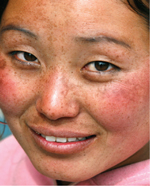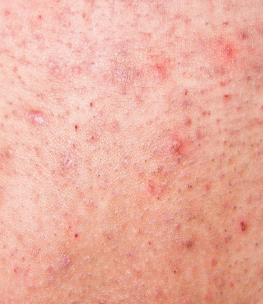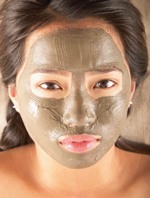You hear about the importance of diversification all the time – businesses must diversify their product offerings; investors must diversify their holdings; job applicants must diversify their skill set, and so on. Chances are... you have already diversified your spa menu offerings; however, are you prepared to work with an ethnically diverse clientele?
Ethnic skin encompasses a broad spectrum of skin types. As a global society, being adept at working with diverse skin types is becoming increasingly important. The nation’s racial and ethnic groups are growing more rapidly than the non-Hispanic White population. In 2011, infants of ethnically diverse backgrounds under the age of 12 months made up 50.4 percent of the United States population. It is projected that by 2050, non-Hispanic Whites will become the minority population at 47 percent. Are you prepared to accommodate this evolving market?
The wise skin care professionals will hone their skills and glean knowledge in the field of ethnic skin by learning the primary differences and complexities specific to skin of color along with treatments that are the most effective. It is also essential to know which ingredients suit each skin’s pigmentation and sensitivities.
The Sensitivities of Ethnicities
 Though there are many universal skin issues that affect all ethnicities, genders and ages, each group has common skin disorders that are unique. These skin disorders can also show up in different ways, depending on skin type. For instance, keratosis pilaris (rough patches and small, acne-like bumps) is a common skin issue among all groups, but the way in which it appears in fair skin (red, irritated patches or pin-sized white papules) versus dark skin (irritated, raised black dots) is very different.
Though there are many universal skin issues that affect all ethnicities, genders and ages, each group has common skin disorders that are unique. These skin disorders can also show up in different ways, depending on skin type. For instance, keratosis pilaris (rough patches and small, acne-like bumps) is a common skin issue among all groups, but the way in which it appears in fair skin (red, irritated patches or pin-sized white papules) versus dark skin (irritated, raised black dots) is very different.
Another example can be drawn from acne. Darker skin affected by acne will often reveal significant inflammation below the skin’s surface via non-inflammatory lesions on the surface. This heightened sensitivity to inflammation explains why acne in darker skin, no matter how mild, will almost always result in post-inflammatory hyperpigmentation (PIH).
In addition to keratosis pilaris, pseudofolliculitis barbae (PFB), acne or folliculitis keloidalis may also cause PIH in ethnic skin. It is estimated that 65 percent of individuals with Black skin and 53 percent of Latino or Hispanic and Asian individuals experience some form of hyperpigmentation. This may occur from skin inflammation due to acne conditions, sun damage, irritations, misuse and overuse of certain skin care products, over-stimulation from peelings, improper or aggressive extractions, and microdermabrasion. Caution must be taken when treating PIH, whether by creating a home care system or rendering a professional treatment.
Asian skin, though no more susceptible to pigmentation and acne issues than other skin types, is among the most challenging skin types to treat simply because it is highly sensitive. Cautionary tactics are important with citrus and fruit-based enzymes, as well as microdermabrasion, particularly if the skin is dryer and thinner. It is also important to avoid fragrances, dyes, and certain botanicals when treating Asian skin.
Another issue worth mentioning is dermatosis papulosa nigra (flesh moles), which is almost exclusive to Black skin and is typically hereditary. The brown or black raised spots are not cancerous and usually appear on the cheeks and just below the eyes.
There are also significant differences among racial groups when it comes to the amount of ceramides within the stratum corneum. The lowest levels are in Black skin, followed by White skin, Hispanic/Latino, and Asian skin, respectively. A lower ceramide level often translates to lower water content in the skin. Knowing this will aid professionals in recognizing which skin types will require more hydration support.
Ingredient Intelligence
 While every client will have ingredients that work best with their skin, there are a few that generally work with most skin types that produce beautiful results. Some of the intelligent ingredients that work well with ethnic skin types include:
While every client will have ingredients that work best with their skin, there are a few that generally work with most skin types that produce beautiful results. Some of the intelligent ingredients that work well with ethnic skin types include:
- Epidermal Growth Factor (EGF) – an essential protein and powerful cell regenerator that supports cell renewal and wound repair.
- Daisy Flower (bellis perennisi) Extract – a gentle, yet highly effective natural skin lightener that influences different pathways involved in balancing hyperpigmentation, melanin formation, and counteracting age spots.
- Alpha Hydroxy Acids (AHAs) – naturally occurring, nontoxic organic acids. The most commonly used include glycolic (from sugar cane) and lactic (from milk). Others include malic (apples), tartaric (grapes), and citric (citrus) acid.
- Salicylic acid – a beta hydroxy acid extracted from wintergreen and birch. It is a relatively safe, low-risk acid, as it is self-neutralizing and produces a drying and lifting effect.
- Retinol – a vitamin A derivative that converts to retinoic acid and is a DNA regulator. It assists in the synthesis of collagen, aids in the formation of blood vessels, and encourages healthy cell formation.
- Trichloracetic Acid (TCA) – nontoxic, keratolytic and self-neutralizing, and very effective in low strengths. It can be used alone or in tandem with other acids. It will penetrate only if it is used in an aqueous base.
- Melanin Suppressants – typically a combination of natural lightening ingredients such as kojic acid, L-arbutin, azelaic acid and L-ascorbic acid.
- Thermus Thermophilus Ferment Extract – a deep-sea microorganism used to fight free radicals.
- Resveratrol – a powerful antioxidant found in red grapes and wine that delivers polyphenols, anti-inflammatory properties, and ultraviolet (UV) and free radical protection.
The Treatment Room: Bringing it all Together
Knowing the sensitivities and challenges that persist, how does the skin care professional proceed and achieve success in the treatment room? They should begin slowly and work gradually to get to know each skin type and what treatment is most suitable. The goal in the treatment room is to work progressively to avoid increasing pigment and disrupting the skin by overdoing extractions, using too many layers of acid, or being heavy-handed with microdermabrasion.
The skin care professional should also find out what the client is using at home. If it includes AHAs, retinol or Retin-A, their skin may be more receptive to acids, which may make the peel treatment more intensive. It is also imperative that a client history of previous treatments, use of medications, previous sun damage, and so on is gathered.
Additionally, treatment intensities must be acknowledged since they will always vary by client and skin challenge rather than color. There are a few skin challenges that are more common to certain ethnicities. For example, Caucasian skin is often more susceptible to premature aging and dryness; Latino and Hispanic skin are prone to hyperpigmentation, scarring, PIH, and uneven skin tone; Asian skin is sensitive and more prone to acne discoloration; and Black skin is sensitive to PIH, keloid formation, and ingrown hairs.
For instance, when working with Asian skin types, keep product selection minimal to determine what is most suitable as this skin has reactive tendencies. Begin with progressive peelings and corrective facials, using extreme caution if integrating microdermabrasion. For individuals with Black skin, it is important to use caution and keep in mind that this skin type generally responds well to a more rapid progression and a fairly aggressive home regimen of topicals that stimulate cell turnover, lighteners and brighteners, and antibacterial support. Knowing some of the common challenges among these groups is highly beneficial. The following are examples of treatments that may bring skin to optimal skin health.
Oily, Acne and Congested Skin
This progressive treatment works well with most Asian skin types. Its goal is to provide the skin a workout by exfoliating dead layers and infusing the skin with antioxidants, essential moisture, and protection:
- Cleanse – Use a pumpkin-based cleanser for antioxidant support and a deep cleanse.
- Enzyme Application Phase 1 – Use a combination exfoliant of papain and low-strength acids (L-lactic, acetic and salicylic) in a liquid delivery. This will support tissue regeneration as well as dissolve and exfoliate keratin. The skin will be stimulated, smoothed and polished.
- Enzyme Application Phase 2 – Use a natural papaya and pineapple gel-based enzyme to lift dead cells and create a mild granular exfoliation.
- Nourishment and Mask – Recharge the skin with a cocktail of antioxidants, L-ascorbic acid, peptides, grape seed extract, resveratrol, vitamin E, and omega-6 EFAs to regenerate, strengthen, rebuild and protect the skin. The potent dose of peptides and antioxidants in the treatment will tone the skin and provide relief from free radical damage.
- Finish – Refresh the eyes with a powerful peptide serum and protect the skin with a zinc-based mineral protection formula.
The blend of exfoliation, infusion of peptides and antioxidants, and contrast of hot and cold via a warm compress and chilled ice globes works to stimulate facial muscles, creating a workout which leaves the skin glowing and instantly firmer.
 Dry, Aged and Dull Skin
Dry, Aged and Dull Skin
This treatment works well with most Caucasian skin types by hydrating, lightening and nourishing the skin through the use of flower acids. The skin is left radiant and glowing:
- Cleanse and Tone – Begin with a citrus-based cleanser for a gentle, yet effective cleanse. Tone the skin with a L-lactic and L-ascorbic combination formula to neutralize free radical damage.
- Enzyme Application – A combination of a milk-based mask and an L-lactic acid, bromelain enzyme, and pineapple acid formula will smooth and brighten the skin, digest cells, and stimulate the regeneration process.
- Acid Application – A hibiscus, mandelic, phytic and pyruvic acid formula, also recognize as a second generation AHA, will provide non-irritating exfoliation while lightening, healing and hydrating the skin.
- Nourishment – Nourish the skin with deep-sea strains, plant stem cells, trace minerals, and omega-6 EFAs to strengthen and protect the skin.
- Mask – Use a mask containing flower acids to provide hydrating, antioxidant and lightening support.
- Finish – Complete the hydration with a cucumber and humectant-based heavy water spray, along with additional flower support from rhodiola rosea extract, and protect with a mineral sunscreen.
Hyperpigmented and Discolored Skin
The goal is to correct the hyperpigmentation as well as support the strengthening and integrity of the skin’s collagen and elastin. This treatment works adequately with most Black skin types:
- Cleanse and Tone – Start with a glycolic-based cleanser to control bacteria and soften the cells. Follow with a fruit acid regenerating lotion to control breakouts and inflammation.
- Enzyme Application – Apply a TCA/AHA formula to break down dead cells, smooth rough texture, and reduce hyperpigmentation.
- Acid Application – Continue the lightening and brightening with a combination of a melanin suppressant solution and a complex of kojic acid, TCA and bentonite clay. This will increase cell turnover, reduce pigmentation and re-mineralize the skin.
- Nourishment – Nourish the skin with deep sea strains, plant stem cells, and trace minerals to strengthen and protect the skin.
- Finish – Protect with a mineral-based sunscreen and be sure to send clients home with an epidermal growth factor (EGF).
Pigmentation and Photo-aging
- The goal of this treatment – which works well with most Hispanic and Latino skin types – is to dissolve and soften keratin cells, improve texture, and brighten pigmented skin.
- Cleanse and Tone – Begin with a pumpkin-based cleanser for antioxidant support, followed by an AHA gel to start the cell turnover process.
- Pre-treatment – Apply a melanin suppressant formula to lighten the skin and provide support during peels to minimize PIH.
- Acid Application – Use a pumpkin-based peel solution, which offers a wide spectrum of vitamin A derivatives, to repair photo-damage, pigmentation disorders, and infuse the skin with antioxidants and beta-carotene.
- Nourishment – Nourish the skin with a pumpkin and vitamin E serum for additional antioxidant support.
- Finish – Apply an epidermal growth factor to support the regeneration of strong, healthy skin. Finish with a zinc-based mineral blocker for protection.
These treatments are merely a starting point and meant to provide ideas. Every client is different and a thorough client consultation and skin assessment will determine the best course of action. During treatment, a skin care professional must make it a point to examine each client’s skin to observe its responses, and proceed with caution when applying any peeling agent.
Being able to serve a diverse clientele is an essential skill set to have and it will help every skin care professional stand out in a saturated market. Having the ability to effectively treat a variety of skin challenges, regardless of the individual’s ethnicity, will also be incredibly rewarding.
 Rhonda Allison, a pioneer in the skin care industry, is the founder and C.E.O. of Rhonda Allison Cosmeceuticals and RA for Men. She is also an author and internationally known speaker with more than 30 years of aesthetic experience. www.rhondaallison.com and www.ramethod.com
Rhonda Allison, a pioneer in the skin care industry, is the founder and C.E.O. of Rhonda Allison Cosmeceuticals and RA for Men. She is also an author and internationally known speaker with more than 30 years of aesthetic experience. www.rhondaallison.com and www.ramethod.com
Want to read more?
Subscribe to one of our monthly plans to continue reading this article.